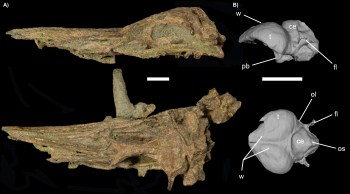Penguin Brains Not Changed By Loss of Flight
October 12, 2016

Losing the ability to fly gave ancient penguins their unique locomotion style. But leaving the sky behind didn’t cause major changes in their brain structure, researchers from the Jackson School of Geosciences suggest after examining the skull of the oldest known penguin fossil.
The findings were published in the Journal of Anatomy in February 2016.
“What this seems to indicate is that becoming larger, losing flight and becoming a wing-propelled diver does not necessarily change
the (brain) anatomy quickly,” said James Proffitt, a graduate student at the Jackson School of Geosciences who led the research. “The way the modern penguin brain looks doesn’t show up until millions and millions of years later.”
Proffitt conducted the research with Julia Clarke, a professor in the Department of Geological Sciences, and Paul Scofield, of the Natural History at the Canterbury Museum in Christchurch, New Zealand, where the skull fossil is from.
“It’s the oldest (penguin) following pretty closely after the loss of flight and the evolution of flightless wing-propelled diving that we know of,” Proffitt said.
The research was funded by the National Science Foundation modern penguin brain looks doesn’t show up until millions and millions of years later. Proffitt conducted the research with Julia Clarke, a professor in the Department of Geological Sciences, and Paul Scofield, of the Natural History at the Canterbury Museum in Christchurch, New Zealand, where the skull fossil is from.
“It’s the oldest (penguin) following pretty closely after the loss of flight and the evolution of flightless wing-propelled diving that we know of,” Proffitt said.
The research was funded by the National Science Foundation.
Back to the Newsletter